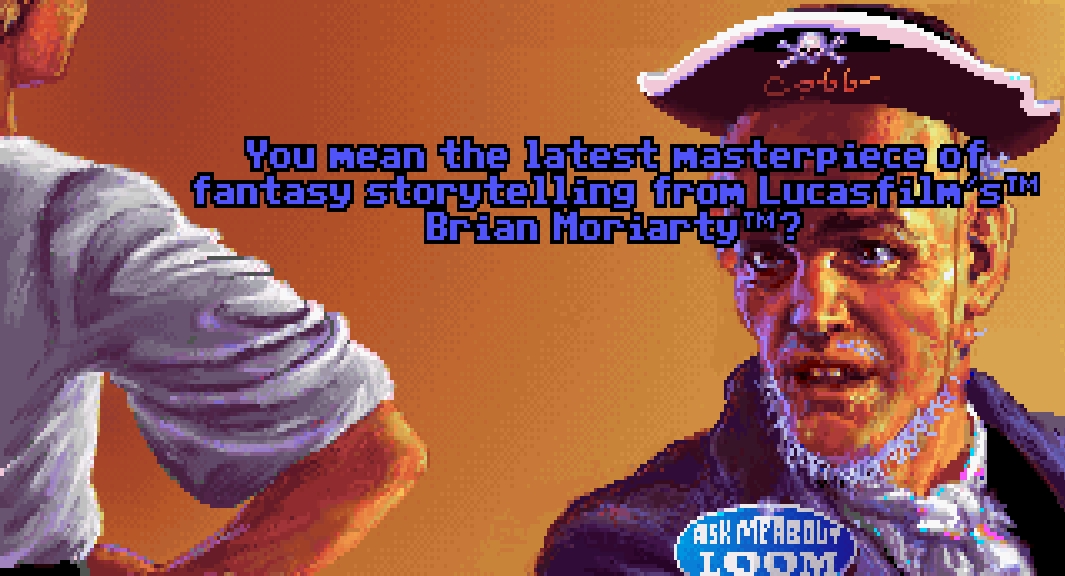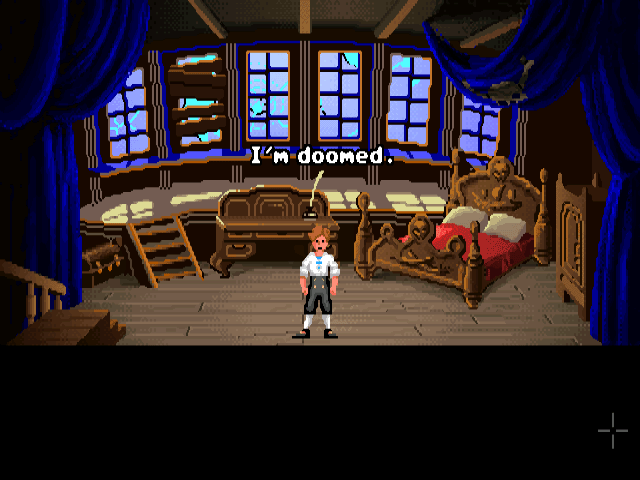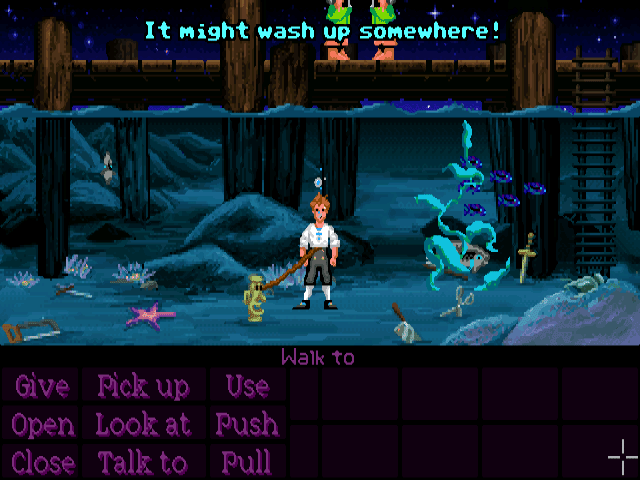Articles

LucasArts' Secret History #5: The Secret of Monkey Island Trivia and Downloads
Trivia, and lots of it!

The titular Secret, repeatedly referenced throughout the series, has never been officially revealed by creator Ron Gilbert, though a popular fan theory is pretty convincing to us. We'll save that discussion for next month's article, though. :)
The Pirates of the Caribbean ride from Disneyland is a clear influence on this game and its universe, but Ron Gilbert cites the Tim Powers' novel On Stranger Tides as at least as heavy an inspiration. The book, for example, features voodoo elements.
Ron had planned to make this game after Maniac Mansion, but the sudden production of Indiana Jones and the Last Crusade (necessitated to release it in time for the movie) forced him to temporarily put it on the backburner. Apparently a rough design, flowcharts, and even some background art had been made by this time.
The SCUMM Bar is named after SCUMM (Script Creation Utility for Maniac Mansion), the engine/scripting language used in various forms to power most of LucasArt's graphic adventure games.
At one point the idea was proposed, allegedly by Dave Grossman, that the Giant Monkey Head was in fact a giant robot. It is unknown how serious the suggestion was meant to be, but in any event it was rejected. However, ten years later in the fourth Monkey Island game, the idea was resurrected and used in the actual game to a rather cold reaction from longtime fans (or some of them, anyway - Ed.).

Guybrush's name came from the software used create the character sprites, Dpaint, which would save the images as .brush files. Saving one of the character sprites as "guy.brush" gave someone the idea to make it the actual main character's name. Guybrush's last name, "Threepwood," was the result of a company vote and apparently was Dave Grossman's preferred handle when creating RPG characters.
This game was first major project for Tim Schafer and Dave Grossman, who at the time were part of a group of junior programmers called "SCUMMlets" (described by Schafer as "the lowest rung on the programming totem pole"). As the game had already had some artwork completed before production ramped up, the Scummlets' first task was to get the game up and running to a preliminary degree. While doing this, they began to write humorous placeholder dialog for the characters to amuse each other. The Scummlets never thought they were doing anything more than fooling around, but when Ron saw the dialog he insisted that it would be part of the actual game.
Although Ron Gilbert was the game's project leader, it's estimated that in terms of design, programming, and dialog writing, he, Grossman, and Schafer are each responsible for about a third of the game's content. Gilbert has credited Grossman and Schafer's writing talent as significantly responsible for the quality of the final game, and has called finding them for the project "pure luck."
Tim Schafer was inspired by a book about salesmen that he had read when he was giving Stan his personality. The dialog was written directly into the code in those days and according to Ron Gilbert, Schafer would program and write the dialog simultaneously.
Ron Gilbert, Dave Grossman, and Tim Schafer would often work out the design for the game over a half-sized pool table in Gilbert's office.
The character close-ups of Elaine Marley and Carla the Swordmaster are based on the likenesses of real counterparts of LucasFilm Games employees at the time – Carla Green (Product Support) and Avril Harrison (artist), respectively. Also, such character close-ups, an idea carried over from Loom, would not, at least in that form, be continued in future games.
This was the first game in which, for the most part, the player could neither be killed nor run into a dead-end. The minor exception to the former is a gag in which Guybrush drowns after the player intentionally leaves him underwater for ten full minutes (the character's capacity for holding his breath). Also the game does indeed reach a dead-end if you literally empty all of your piece of eight into the grog machine. It is also possible to toss all of your burnable items into the cooking pot on the Sea Monkey, thus enabling you to be unable to light the cannon fuse later. The game intentionally makes it impossible to cook the treasure map to avoid this dead-end, but it's possible to never need to get the map in the first place if you navigate the Mêlée Island forest maze on your own. It's probably more accurate to call these two things bugs rather than design faults though.
A famous gag in the forest involves Guybrush peeking into a hollowed out tree stump to claim that it leads into a massive system of undergrounds catacombs. The game then prompts that the player insert a nonexistent "Disk 22." The CD version of the game removed this gag, as well as the reference to it in the ending credits. The "stump joke" reportedly caused the LucasFilm Games hintline much grief to the point where it had to be officially addressed as a joke. This gag would also be referenced several times in later games.
- Tim Schafer
Spiffy, the dog that you can talk to in the SCUMM Bar, was intended to have a character close-up (which can be seen on the back of the game's box), but the background was removed due to space constraints.
There are those who claim that the man inside the troll costume was intended to resemble George Lucas. This rumor is unconfirmed, though the Monty Python reference must surely have been intentional.
Steve Purcell's (who was also an artist and animator on this game) popular comic strip characters Sam & Max make appearances as an idol to the Great Monkey Head.
When attempting to talk his way out of a confrontation with the ghost pirates when walking onto LeChuck's ships without the invisibility necklace, Guybrush can say the line, "I've come to interrogate the prisoner," which is taken directly from Indiana Jones and the Last Crusade.
Steven Spielberg is apparently a fan of this game, as well as other LucasArts graphic adventures. According to employees, Spielberg was an avid gamer who spent more time in the Games Department upon his visits to Skywalker Ranch than George Lucas himself did.
The behind-the-wall gag that takes place when Guybrush is looking for the idol in the governor's mention was proposed as a joke by Dave Grossman in lieu of the original, more convoluted puzzle. Ron Gilbert liked this throwaway idea so much it was implemented in the actual game.

An entire ship-to-ship combat segment of the game was cut out for time/space constraints, much to the dismay of Tim Schafer, who apparently still keeps the design for it in his archives.
If you remain underwater long enough you will overhear a conversation involving two Mêlée citizens above the dock. Staying beneath the surface longer still (ten minutes total, the duration Guybrush claims he can hold his breath) will result in Guybrush drowning, which is the only way to die in the game. Once he's dead, the game's action verbs will be replaced with such words as "Float," "Bloat," and "Order Hint Book."
According to Ron Gilbert, having character sprites of citizens walking around Mêlée Island was only the tip of the iceberg of what he wanted to do to make the game world seem more "alive," but time restrictions prevented anything more ambitious.
Unlike in previous LEC adventure games, the cutscenes in Monkey Island are triggered by player events (i.e. Guybrush leaving the SCUMM Bar for the first time) rather than an internal clock.
This is one of the first adventure games to use character scaling, where characters decrease and increase in size depending on their location in the two dimensional background. (Last Crusade actually had this feature as well: see the exterior of the Venice librarry).
If you press Ctrl+Alt+W at any point in the game, you are asked if you're "sure you want to win." Upon confirming, you are told that you've won and have scored 800 out of a total of 800 points, followed by the end credits. This gag would be carried over in future Monkey Island games.
- Orson Scott Card
Orson Scott Card penned the insults for the swordfighting section of the game.
Rumor has it that a talkie version of the game was once considered at some point, but this apparently never went any further than employees recording some dialog as a test.
This was the first project for Michael Z. Land, game composer extraordinaire.
While the original EGA version of the game has a sunset in the background of the Melee Island dock, the updated 256 color version makes it purely night.
The optional line "It belongs in a museum!" when Guybrush explains his motivation for stealing the Idol of Many Hands is from the film Indiana Jones and the Last Crusade.
In the game's demo, attempting to pick up the chalice in the Voodoo Lady's place transforms Guybrush into Indiana Jones. Additionally, looking at the chalice in both the demo in final release prompts Guybrush to say, "Now THIS is the cup of a carpenter."
In the Amiga version of the game, when Guybrush creates a minor explosion to destroy the dam and unblock the river, a small chest can be seen flying off the screen. In all other versions, this chest is a large rock. When asked about the significance of the chest in an interview, Grossman quipped that it contained the secret of Monkey Island.
Future Monkey Island 4 (which would be made a full decade later) project leads Mike Stemmle and Sean Clark served on this game as playtester and Macintosh converter respectively.
The character Cobb from Loom appears in this game as a patron of the SCUMM Bar, wearing a button that reads "Ask me about LOOM." Upon doing so, an extended advertisement from the game follows, whereas any other form of communication with Cobb results in his indifference. Cobb is credited at the end of the game.
The Loom seagull appears on the dock beyond the SCUMM Bar kitchen. The seagull is also credited at the end of the game.
The cereal boxes that Guybrush finds in the cupboard onboard the Sea Monkey appear to be intentionally similar in design to the real cereal Cap'n Crunch.
Originally, Meathook was to demand that Guybrush complete three tasks before accepting him as captain. This was cut down to one as the puzzle was deemed unnecessarily complicated.
Much of the design was changed in a significant way during the course of development, and dialog lines were written and polished up until the very last minute. Team members have pointed out that such changes would not be possible today, where game design and dialog has to be completed upfront and locked down.
The character of Herman Toothrot was invented when it was realized that the player needed someone to talk to on the nearly uninhabited Monkey Island.
The game features two possible endings, depending on whether or not you sink Guybrush's ship while using the "primitive art" boulder launcher on Monkey Island. If you do not sink the ship, Guybrush and his crew return to Mêlée Island without Herman Toothrot. If the ship is destroyed, Guybrush and Herman escape Monkey Island in Herman's ship, leaving the crew behind. Interestingly, the storyline of the fourth Monkey Island game assumes the scenario where Guybrush abandoned his crew occurred, leading people who were only familiar with the ending in which Toothrot is abandoned confused about that game's continuity.
The "rubber tree" gag that pokes fun at Sierra was put in by Dave Grossman. He's recently noted that such spur of the moment gags were relatively easily implement in those days.
One of the possible dialogue options available for Guybrush when he believes to be breaking up Guybrush and Elaine's wedding – "ELAINE!" - is a reference to the film The Graduate.
Due to manufacturing limitations for the company at the time, LucasFilm Games employees were shipped to the warehouse to physically fill and shrinkwrap the boxes for the first printing of this game.
If you continuously get caught by the cannibals after escaping from the hut, their doors get more and more over the top each time they lock you up, until it becomes an armed steel security door similar (intentionally or no) to the one in Maniac Mansion.
For its copy-protection, the original game came packaged with a unique codewheel which, when configured to match two faces of historical pirates as indicated on the game's opening screen, would yield a year (four digit number) which you would have to type in to start the game.
The CD version changed the interface a bit, most notably representing inventory with icons and enlargement the verbs, making it consistent with Monkey Island 2.
One of the game's many ports was for the SEGA CD. The poor performance of this rather bizarre version led LucasArts to cancel their planned ports of the sequel and Indiana Jones and the Fate of Atlantis. Additionally, a version of the game for the Commodore was apparently in development at some point before being cancelled.
If you want evidence of the game's devoted following, look no further than the friggin' Monkey Island play! Yes, a fan literally put on a stage production of The Secret of Monkey Island, complete with sets and props and costumes and everything. Give it a look.
Further Reading:
Miscellaneous Monkey Island Oddities -- ATMachine's page, filled to the brim with incredibly obscure and detailed trivia that redefines "obsessive." I recommend checking out the whole site!
Soundtrack Island -- Staffer Zaarin has painstakingly recorded the game’s soundtrack in its original form! Why are you not downloading it (and other LucasArts soundtracks) now?!
The SCUMM Bar -- They may be inactive now, but as a resource The SCUMM Bar is still the best Monkey Island site ever, man. No really, they’ve got it all.
The World of MI -- They're dead now, but one time they weren't.
The Legend of Monkey Island -- See above.
The Secret of Monkey Island Wikipedia page -- But we knew everything they had on there anyway!
Monkey Island: The Play -- That's all there is to say, really.
Idle Thumbs Ron Gilbert Interview -- Former Mojo staffers go one on one with the creator of the series in this interview for the ages. See also the second and third installments.
Debugging Information -- Technical genius "bgbennyboy" displays information on how to debug Monkey Island 1, and other SCUMM games, enabling you to teleport into different sections of the game.
Monkey Island Fan Work -- The series has spanwed more fan arts and musics than anything else in the universe, probably, and the quality of it is staggering. My personal favourite for S.O.M.I fan art is Ado Ceric's Mêlée Island Church: a brilliant re-imagining of the scene from the game.
Ron Gilbert comic strip -- The real secret of Monkey Island, maybe.